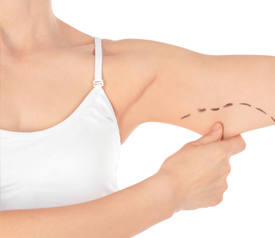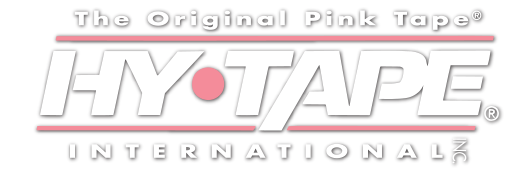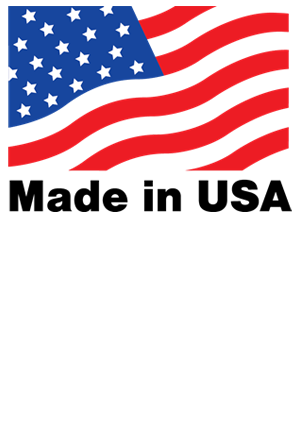
Brachioplasty, also known as an arm lift, is a plastic surgery procedure to remove excess, sagging skin from the upper arm. Skin in this area sags with age (i.e. senile elastosis) despite diet, strength training, or toning exercises. Thus, the arm lift has long been a popular cosmetic surgical procedure among older individuals, especially women. However, the increase in bariatric/weight loss surgery has dramatically increased requests for arm lift procedures. The massive weight loss people enjoy after bariatric surgery leaves various areas of the body with excess skin, including the upper arm. For these reasons, brachioplasty has become one of the most popular aesthetic surgical procedures, but it is associated with certain complications.
A brachioplasty scar is common
Surgeons have published over two dozen ways to perform an arm lift. Why so many surgical approaches? Because the upper arm is a particularly difficult place on which to perform surgery. Surgeons must avoid nerves, major arteries, and the lymphatic system. The natural anatomy (e.g. fascia) of the upper arm makes it difficult to make aesthetically favorable incisions. Moreover, it becomes difficult close the surgical wound is a way that provides a good cosmetic result.
Even under the best of circumstances, most patients will be left with a brachioplasty scar. This brachioplasty scar is often noticeable to some degree when the patient exposes the underside of their bare arms. Several complications, either during surgery or during arm lift recovery, may make the brachioplasty scar worse. Deformities ranging from small wound separations to wound dehiscence can leave patients with an unsatisfactory cosmetic result.
Other arm lift complications
A brachioplasty scar is only one of the possible arm lift complications. Because of the length and location of the incision, brachioplasty pain is also relatively common. Other arm lift complications include infection, seroma (i.e., fluid collection), lymphedema, inability to close the arm, nerve compression, sensory loss, compartment syndrome, and bleeding. Fortunately compared to brachioplasty scar and brachioplasty pain, these other arm lift complications are relatively uncommon. On the other hand, if they do occur, they can increase the risk of having a brachioplasty scar that is more noticeable or less cosmetically favorable.
The importance of proper arm lift recovery
Fortunately, patients can take specific steps during arm lift recovery to reduce the risk of arm lift complications including unfavorable brachioplasty scar formation. While it seems obvious, it is critical to follow your surgeon’s post-brachioplasty instructions carefully. This includes attending all follow up appointments and adhering to all activity restrictions.
What to expect during arm lift recovery
After brachioplasty, most plastic surgeons will cover the surgical wound with bandages and medical tape. These bandages may be covered by elastic/compression bandages to reduce the risk of swelling and to keep the edges of the wound in place. Many surgeons also include small drainage tubes and reservoirs to collect excess fluid that may accumulate during arm lift recovery. It is important to follow specific instructions about bathing, dressing changes, and wound management you will receive. You may be asked to check the wound for signs of infection or avoid getting the area wet for a period of time. It may be possible to take sponge baths soon after brachioplasty surgery (ask your doctor). Some patients may need to take oral antibiotics or to apply anti-bacterial creams/ointments. Again, follow instructions carefully and fully.
Many patients find the activity restrictions during arm lift recovery challenging. Patients may be asked to refrain from lifting their arms above their shoulders for several weeks. In the case of a bilateral arm lift (both arms treated during the same surgery), certain grooming tasks like washing and combing hair are nearly impossible. However, the importance of these restrictions cannot be overstated.
How to minimize a brachioplasty scar
Keep the wound edges secure
Simply put, the better that skin is allowed to perform its natural healing process, the less noticeable the brachioplasty scar will be. One of the main ways to avoid a bad brachioplasty scar is to keep the edges of the wound together (i.e. approximated) and stable. The newly formed skin will look different than the original skin (i.e. a scar), but the thinner the gap between healthy sides of skin, the smaller the scar. Also, the less tension that is placed on the healing wound, the smaller the brachioplasty scar.
Keep a moist wound environment (but not too moist)
The wound should be kept moist, but not overly moist. Skin forms best in a hydrated environment—and the immune cells work best in this environment, too, However, too much moisture can dilute these helpful molecules. Keeping the wound covered is often enough to keep the wound from drying out. Ask your doctor if you need a source of extra protection, like a petroleum jelly product or something similar. On the other hand, frequent dressing changes can help excessively moist wounds stay dry.
Keep away ultraviolet rays
Newly forming skin and scar tissue is incredibly sensitive to the harmful effects of UV rays. The sun can darken a brachioplasty scar—darker than the surrounding skin. If safe to do so, keep your surgical scar covered with sunscreen (at least 30 SPF). If not safe to do so, keep it covered with occlusive medical tape or another UV protective barrier.
Keep eating healthfully
While there is limited evidence to suggest that oral supplements affect wound healing, it stands to reason that good nutrition is good for the body and healing skin. Surgery increases the metabolic demands on the body. In other words, you use up more macronutrients, vitamins and minerals during surgery and recovery than usual. Eating right can help you sustain and rebuild.
Choosing the right medical tape
While it may not sound critical, choosing the right medical tape during arm lift recovery can make a difference. Hy-Tape is an excellent choice if your goal is to help minimize a brachioplasty scar. Hy-Tape holds strong, even under unforgiving environments. It conforms to skin more rigorously as it warms to body temperature. It also conforms to the contours of the body. These are important qualities for tape that will be affixed under the arm and the axilla (i.e. armpit). Thus, if Hy-Tape is placed as instructed, it can help hold bandages and wound edges in place, which is important for minimizing a brachioplasty scar.
Despite holding firm, Hy-Tape’s zinc oxide-based adhesive removes cleanly and easily during dressing changes. Hy-Tape is gentle on delicate, friable, or post-surgical skin when it is removed.
Hy-Tape also provides protection from the sun. It has been rated as a Sun Protection Factor or SPF greater than 50. Thus, Hy-Tape can help protect delicate skin and the newly forming brachioplasty scar from harmful UV rays.
As you prepare for brachioplasty and are collecting the supplies you need during arm lift recovery, consider Hy-Tape for your medical tape needs.
Learn more about protecting scars from the sun and minimizing scars.
- Minimize the Appearance of Scars
- Minimizing Breast Reduction Surgery Scars
- Relief & Care for Hypertrophic & Keloid Scars
- Care for Thyroid Surgery Scars
- Hy-Tape for Wound Care and Scar Management
- A Moms Review After Her Daughters Life Changing Surgery
- Reducing Your Risk of Developing a Basal Cell Carcinoma Scar

